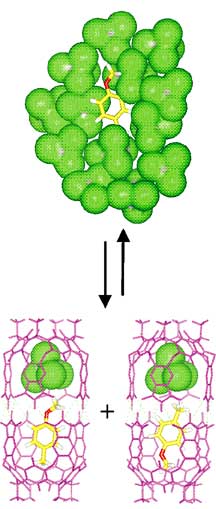Observing a Single Solvent–Solute Association
By Jason Socrates
Bardi
Dissolved molecules, like misery, love company.
Typically any "solute" molecule that is dissolved in liquid
phase—the "solvent"—will be surrounded by a cage
of hundreds or even thousands of such solvent molecules. These
associations are fickle. The cages constantly form and dissipate
through diffusion, and have lifetimes of less than a nanosecond.
This makes studying the interactions between one solvent and
one solute molecule difficult.
Or perhaps exceedingly difficult.
In the 1960s, scientists studied these sorts of detailed
interactions by blasting streams of solute and solvent molecules
in the gas phase into each other under extremely high vacuums.
But nobody has ever been able to look at the detailed interactions
between one solvent and one solute molecule in the liquid
phase.
Now a technique invented at the Skaggs Institute for Chemical
Biology at The Scripps Research Institute (TSRI) allows scientists
to do just that.
In a study funded by The Skaggs Institute for Research and
the National Institute of General Medical Sciences, TSRI Research
Associates Alessandro Scarso and Alex Shivanyuk and TSRI Professor
Julius Rebek, who is the director of the Skaggs Institute
for Chemical Biology, studied the fundamental forces of biological
chemistry between the solvent and the solute in the liquid
phase.
The new method, which they call coencapsulation, temporarily
places one molecule each of solute and solvent into a self-assembled
capsule. The capsule is something like a drug capsule on the
nanometer scale—with two half nano-capsules coming together
to form a nanocapsule around a solute and a solvent. This
coencapsulation is reversible and typically lasts for about
one second.
Using nuclear magnetic resonance spectroscopy, Scarso, Shivanyuk,
and Rebek studied different solutes with a panel of 15 common
organic solvents—like chloroform, benzene, acetone, propanol—at
room temperature in the liquid phase, and they were able to
observe the weak attractive and repulsive intermolecular forces,
such as hydrogen bonding, van der Waals interactions, and
dipole–dipole coupling, between a single solvent and
a single solute molecule. They were even able to determine
the orientation of the solvent with respect to the solute
that results from these attractive and repulsive forces.
This is the first time the interactions of an individual
solvent molecule with an individual solute molecule have been
observed under such favorable conditions.
To read the article, "Individual Solvent/Solute Interactions
through Social Isomerism" by Alessandro Scarso, Alexander
Shivanyuk, and Julius Rebek, Jr., please see the November
19, 2003 issue of the Journal of the American Chemical
Society or go to: http://pubs.acs.org/cgi-bin/asap.cgi/jacsat/asap/abs/ja037808e.html.

|

One solute molecule is normally surrounded by a field of solvent
(top). But the technique described by TSRI researchers allows
them to sequester one solvent and one solute molecule and
study the interactions between them. Picture
courtesy of Alessandro Scarso.
|

